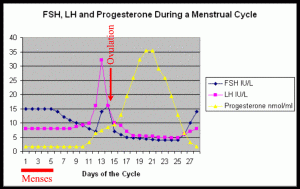Responding to low levels of estrogen, the hypothalamus sends a signal to the anterior pituitary gland to release follicle stimulating hormone (FSH).
In addition to stimulating ovarian follicular growth, FSH also stimulates the granulosa cells of the follicle to produce gradually increasing amounts of estrogen.
This estrogen has many effects, including stimulation of the endometrium glandular epithelium to proliferate (reproduce), creating an environment that will later prove hospitable for implantation of a fertilized ovum.

As the estrogen production accelerates, it begins to inhibit FSH and at the same time stimulates luteinizing hormone (LH). This leads to a major surge in LH that peaks 12 to 24 hours before ovulation. This surge in LH is accompanied by a parallel surge in FSH and estrogen.
After the peak of LH, FSH and estradiol, continuing secretion of LH causes the granulosa cells to produce progesterone. In the absence of pregnancy, the progesterone is produced for about 10 days. Then it and estrogen production rapidly decline, leading to a significant withdrawal of hormonal support from the endometrium. This provokes bleeding as the decidualized endometrium is shed, leaving only the endometrial basal layer of cells.
Responding to the low levels of estrogen, the hypothalamus again causes release of FSH from the anterior pituitary, and the cycle begins again.
Normal Bleeding
- Occurs approximately once a month (every 26 to 35 days).
- Lasts a limited period of time (3 to 7 days).
- May be heavy for part of the period, but usually does not involve passage of clots.
- Often is preceded by menstrual cramps, bloating and breast tenderness, although not all women experience these premenstrual symptoms.
Abnormal Uterine Bleeding
Abnormal bleeding has a number of definitions, the simplest of which is, “all bleeding that is not normal.” Abnormal bleeding includes:
- Too frequent periods (more often than every 26 days).
- Heavy periods (with passage of large, egg-sized clots).
- Any bleeding at the wrong time, including spotting or pink-tinged vaginal discharge
- Any bleeding lasting longer than 7 days.
- Extremely light periods or no periods at all
Dysfunctional Uterine bleeding
Dysfunctional bleeding is another term with varying definitions. Some consider bleeding dysfunctional if there is any abnormal uterine bleeding in the absence of uterine pathology or medical illness.
Others feel that drawing such a fine distinction is pointless as many medical illnesses (polycystic ovary syndrome, hypothyroidism, hyperthyroidism, adrenal hyperplasia) can create a pattern of bleeding that is clinically indistinguishable from the traditional “dysfunctional” uterine bleeding.
Many gynecologists use the term abnormal uterine bleeding (AUB) and dysfunctional uterine bleeding (DUB) interchangeably.
